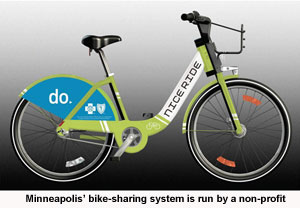
Annual revenues for US non-profit organizations exceed $1.4 trillion (Illustration by Modern Media Leadership Institute)

FRONT PAGE
Site Search
About us



Non-profits vital to urban USA
Nonprofits versus US cities
Vision for metro America
Poverty in US cities
US debates use of marijuana
Catholic Church in urban USA
Funding cities
US poverty 2011
US affordable housing crisis
Black American men
$1.4 billion for US homeless
Poverty in US cities
US school reforms
US urban inequality
US clergy and local politics

Worldwide | Elections | North America | Latin America | Europe | Asia | Africa |


























a vital component of urban America
By Tony Favro, USA Editor*
8 March 2012: Not too many years ago, American cities viewed the non-profit organizations working within their municipal boundaries with suspicion and even condescension. Non-profits opened soup kitchens and homeless shelters that made economic development difficult for city administrators, for what entrepreneur wants to open a new store with homeless people milling about? And city staffs often held the capabilities of their non-profit colleagues in low regard, considering them naïve rather than realistic, dreamers not doers.
• Power and challenges
• New York State study
• National implications
In the 1980s, President Ronald Reagan set in motion new federal policies, which reduced the total amount of federal funds dispersed to local governments. Moreover, federal monies frequently were sent directly to non-profits, bypassing cities entirely. Non-profits began to deliver services in areas formerly the responsibility of cities, including affordable housing, arts and culture, workforce training, environmental sustainability, personal mobility, emergency health care, and neighborhood and downtown revitalization. Non-profits quickly became major players in community and economic development activities that profoundly impact urban quality of life, and cash-strapped cities had no choice but to partner with them.
Non-profit organizations are a “crucial link” between cities and their societies and economies, said the late Michael Guido, former Mayor of Dearborn, Michigan, upon the release of a national survey of 183 cities about emergency preparedness in 2006. Guido was speaking in his role as President of the US Conference of Mayors, and captured the sentiment of many city officials and policymakers. In recognition of this critical linkage, state and local governments across the United States are now working to strengthen the capacity of the non-profits with which they interact.
 Non-profit power and challenges
Non-profit power and challenges
In 2011, there were 1.6 million non-profit organizations registered with the US government, according to the National Center for Charitable Statistics, a clearinghouse for data on the non-profit sector in the United States. This number does not include colleges, universities, and public and private schools. Non-profits currently employ one in ten workers in the US.
The number of non-profits increased 25 per cent between 2001 and 2011, making them the biggest engine for economic growth in many US cities and states over the past decade. It’s fair to say that many cities are defined by their non-profit sectors. The City of Chicago, for example, enters into contracts with 700 non-profits in a typical year.
Annual revenues for US non-profit organizations exceed $1.4 trillion. Governments at all levels account for most of these revenues in the form of payments for services or direct grants. In fact, government is the largest single source of revenues for 62 per cent of all non-profits in the US. Non-profits that don’t rely primarily on public coffers tend to be private foundations, church congregations, chambers of commerce, fraternal organizations, and civic leagues.
A symbiotic relationship of necessity has developed: governments must depend on non-profits for service provision at an affordable cost to taxpayers, and non-profits must depend on government for their financial existence. The precarious economy since 2008 has created strategic, financial, and governance challenges for both governments and non-profits, and both are looking for ways to work together to strengthen their partnerships.
In New York State, a Leadership Committee for Non-profit Revitalization, convened by the state’s Attorney General, recently issued a set of recommendations to reduce the burdens on both non-profits and governments. The Committee consists of 32 senior non-profit executives and scholars from around the state along with the Attorney General and his staff. The Attorney General is the state’s chief regulator. The committee focused on reducing the burden of state regulations and bolstering non-profits’ finances, accountability, and governance. The final report has attracted national attention as a potential model for creative and meaningful solutions for addressing these issues.
New York State study
According to the study, non-profits employ more than 1.2 million workers in New York State, or 18.1 per cent of the total private workforce. New York’s non-profits generate $200 billion in annual revenues, more than any other state in the US.
The central recommendation of the report is new state legislation — a Non-profit Revitalization Act — which would implement a number of key reforms to strengthen oversight of non-profits by their boards and cut back state mandates.
The reforms include:
• Streamlining bureaucratic processes to expedite the approval of key non-profit transactions, as well as the formation of non-profits in New York.
• Modernizing outdated requirements, such as permitting the use of technology to facilitate more efficient and cost-effective operations.
• Requiring boards to provide enhanced and independent oversight of executive compensation.
• Increasing board responsibilities to oversee financial audits.
• Enhancing the Attorney General’s tools to police self-dealing and other forms of corruption.
• Requiring that non-profits adopt conflict-of-interest and whistleblower policies.
One focus of the proposed legislation is to improve the state payment system. The study notes that of the more that 3,800 state contracts with non-profits valued at $50,000 or more in 2010, payments were late 92 per cent of the time, and 72 per cent of all contracts were approved or renewed after the start date. The report also found a lack of efficiency in the payment process. For example, non-profits funded through multiple state agencies must provide the same documentation and audits to each agency each year.
The late and lax system of contracts and payments causes non-profits to waste resources and places many in dire financial straits. The study recommends overhauling the state payment system by, among other reforms, adjusting contract cycles to allow for earlier planning and later contract start dates, allowing appropriate provisions in contracts for continuity of services, moving to standardized and multi-year contracts, paying on time, providing interest-free cash loans when contracts are delayed, and centralizing services at the state level to reduce redundancies.
For their part, non-profit boards would assume greater oversight of financial audits. The state would help non-profits recruit the talented and diverse directors that are needed to ensure proper governance. The state also would offer training to help non-profit boards get the proper financial controls and oversight practices in place.
The board oversight recommendations provoke the most wariness among New York’s non-profits. While all non-profits would benefit from improved contract and payment administration, and large organizations already have the audit and oversight mechanisms in place, many small non-profits are concerned that the new accountability measures may be too costly and burdensome for them to implement and maintain.
The Leadership Committee for Non-profit Revitalization released its recommendations in February. It’s too soon to know how they will fare in the New York State Legislature, whether and in what form they might become law.
National implications
The proposed New York legislation goes beyond strengthening the capacity of non-profits, making the state more hospitable to non-profits, and making the state and non-profits better partners.
The final section of the report, titled The Path Forward, strongly encourages the state and non-profit community to continue to work together to craft a strategic plan for the state’s non-profit sector, “a national model for collaborative and innovative reform that will improve delivery of programs and services to individuals and communities and further strengthen oversight and public trust.”
This gets to the heart of the debate on corporate social responsibility in the United States.
A New York strategic plan and legislation, if crafted and adopted as proposed, could become models for social investment in the United States, supplanting traditional one-off corporate philanthropy with strategic and ongoing social investment founded on a transparent and mutually beneficial network of relationships between government, non-profits, and businesses.
A new social investment model would likely benefit American cities and their residents first, and then percolate through the rest of society.
Resource: New York State Attorney General’s Office, Revitalizing Non-profits, Renewing New York, 16 February 2012
*Tony Favro also maintains the blog Planning and Investing in Cities.
Comment on this article
Read comments
Follow @City_Mayors

